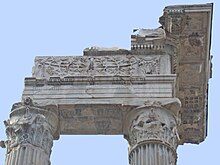Festoon (architecture)
In architecture, a festoon is the decoration of a freely visible underside of structural members. In most cases it is the underside of architraves or archivolts , but they can also be found between the consoles of geisa and cornices .
As a rule, they are long rectangular surfaces that are framed by profiles and filled with ornaments . Framing elements are often pearl rods or kymatias , while the surfaces can accommodate ornaments of different shapes. Tendril motifs , lotus blossoms and palmettes as well as bucrania and candelabra motifs are popular . If the festoons are kept narrow, leaf sticks in the form of stretched garlands - made from bay leaves, for example, as can be seen at the Temple of Zeus in Aizanoi - or braided bands can fill the ornament surface. More square soffits between consoles, for example, are usually filled with rosettes .
literature
- Max Wegner : Ornaments of imperial buildings in Rome. Festoons . Cologne / Graz 1957.
- John Summerson : The Classical Language of Architecture. Vieweg, Braunschweig 1983, p. 136.
Web links
Remarks
- ↑ Rudolf Naumann (Ed.): The Temple of Zeus at Aizanoi. After the excavations by Daniel Krencker and Martin Schede . de Gruyter, Berlin 1979, p. 22 f. Fig. II, plate 55.
- ↑ Reinhard Köster: The architectural ornamentation of Milet. Part 1: The architectural ornamentation of the early and middle Imperial Era (= Miletus. Results of the excavations and investigations since 1899. Volume 7.1). de Gruyter, Berlin / New York 2004, p. 113.
